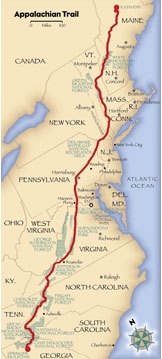Appalachian Trail
 From Conservapedia
From Conservapedia 
The Appalachian Trail is a 2,175-mile long continuous hiking trail that runs through 14 of the eastern United States from Maine to Georgia. Approximately 4 million people each year hike on various parts of the trail, much of which borders the Appalachian Mountains. The trail begins on the summit of Springer Mountain in northern Georgia and ends on the summit of Mount Katahdin in Maine.
The trail is officially named the "Appalachian National Scenic Trail" and is commonly abbreviated as the "A.T.". The entire trail route is clearly marked with signs showing white blazes. Side trails and detour routes which are not part of the Appalachian Trail are usually marked with blue blazes.
The United States Forest Service and the National Park Service are the primary agencies responsible for maintaining the Appalachian trail. The Trail runs through more than 75 different federal and state forests. Much of the trail is maintained by National Park Service Rangers who are assisted by the Appalachian Trail Conservancy, a nonprofit organization dedicated to the protection and management of the trail, and by many civilian volunteer groups who donate their time towards keeping the park lands and trail maintained.[1] There is no charge to hike the rail, and hikers are provided with free lodging in the form of simple three sided shelters, each spaced about a day's journey apart.[2]
The idea for the Appalachian trail is credited to Benton MacKaye of Massachusetts, who later founded the Wilderness Society. A Harvard graduate and U.S. Forest Service employee, MacKaye was a wilderness preservation advocate with an interest in regional planning. His idea was to have a network of work camps and communities in the Appalachian mountains, linked by a trail that ran from the highest point in New England to the highest point in the South.
MacKaye wrote an article detailing his plans which was published in October 1921 in the Journal of the American Institute of Architects. He then organized a group of interested individuals and in 1925 held a conference in Washington, D.C., to promote his idea. This group established an organization called the Appalachian Trail Conference, which was renamed in 2005 and is today known as the Appalachian Trail Conservancy.
Two members of MacKaye's group, retired Judge Arthur Perkins of Connecticut, and lawyer Myron Avery of Washington, D.C., became driving forces in establishing the trail, working to recruit volunteers, establish hiking clubs, and physically clearing brush and marking paths themselves. Avery in particular was key in establishing a network of volunteers, developing hiking clubs, and working with governmental agencies to organize and build the trail.
The Appalachian trail was built in sections and largely completed by 1937.[3] It was designated a national scenic trail in 1968, when Congress passed the National Trails System Act.[4]
Appalachian Trail hikers have developed their own jargon. "Blue blazing" is taking other trails part of the way, some of which are shortcuts to remaining on the Appalachian Trail. "Yellow blazing" is hitchhiking part of the way rather than hiking, in reference to the yellow stripes on highways; both terms have derogatory connotations. "Nobo" and "Sobo" are short for northbound and southbound. A "trail name" is a nickname given to a hiker, often by other hikers with humorous intent. A "thru hiker" or "through hiker" is somebody hiking the entire length of the trail.
The middle point, although not the exact geographical center, of the trail is considered to be Harper's Ferry, West Virginia.
References[edit]
- ↑ http://www.nps.gov/appa/
- ↑ http://www.trailplace.com/
- ↑ http://www.nps.gov/appa
- ↑ http://www.appalachiantrail.org/
Categories: [United States]
↧ Download as ZWI file | Last modified: 02/27/2023 13:59:51 | 6 views
☰ Source: https://www.conservapedia.com/Appalachian_Trail | License: CC BY-SA 3.0
 ZWI signed:
ZWI signed: KSF
KSF